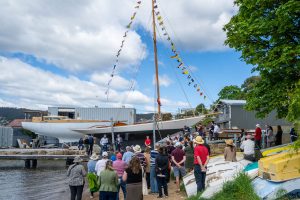Gas giant Australia prepares for the unthinkable: Importing supplies for the first time

- by Admin
- September 4, 2024
On a dock alongside reminders of Australia’s industrial past — blast furnaces and stockpiles of coal — a key piece of the country’s energy future is taking shape.
It is both a beacon of hope for some and, to others, a symbol of successive failures and all that is wrong with Australia’s energy policies.
Crucially, according to industry analyst Rick Wilkinson, it is the “only” solution to a looming gas supply crisis that threatens to push up energy bills in Australia’s most populous states.
“We’re in this position because, quite simply, we’ve run out of time,” says Mr Wilkinson, CEO of consultancy EnergyQuest.
For the first time, and in spite of Australia’s position as one of the world’s biggest gas exporters, the country is preparing to do something that was once unthinkable.
It is on the cusp of becoming a gas importer.
At Port Kembla, a little more than 100 kilometres south of Sydney, the energy company controlled by iron ore magnate and climate evangelist Andrew Forrest is building a $1 billion terminal to import liquefied natural gas, or LNG.
‘Dire’ needs, drastic deeds
Squadron Energy boss Rob Wheals tours the company’s LNG import plant at Port Kembla. (ABC News: Marcus Stimson)
Rob Wheals, the chief executive of Mr Forrest’s Squadron Energy, says the reasons are simple enough — the east coast is about to run short of gas.
“I would go as far to say the outlook is dire,” Mr Wheals tells the ABC on a rare tour of the facility.
“We are facing a critical, structural shortfall by 2028.
“The decline will be as much as 40 per cent from current supply in southern markets and it’s not being replaced. The only solution is right here, right now in Port Kembla.”
The Australian Energy Market Operator (AEMO) is forecasting that within just a few short years, supplies of gas on the east coast could fall well short of demand at peak times, typically in winter.
Sitting behind the forecast is a precipitous decline in Bass Strait reserves, which are processed at the Longford gas plant and have formed the bedrock of supply for the southern states of Victoria, New South Wales and South Australia.
Similar declines are affecting historic fields in central Australia.
In addition, AEMO notes that too few new gas fields have been developed to bridge the impending gap, a consequence of years of building opposition to the gas industry in many places.
Meanwhile, a pipeline connecting southern states to gas-rich Queensland is already at capacity at critical times.
Mr Wilkinson says demand for gas might be falling as appliances get more efficient, people switch to electric options rather than gas ones and renewable energy increasingly comes to the fore.
But he says it is not falling fast enough.
“Even though demand for gas has been falling … what’s happening is that supply has been falling even faster,” Mr Wilkinson says.
“We haven’t found a way to replace that gas.”
Supplies, and views, diverge
The mismatch between gas supply and demand is hotly contested.
To its backers, gas is a crucial input for heavy industry and manufacturing and will play a key role in keeping the lights on as Australia moves away from coal and towards green energy.
They say that failure to ensure enough supplies would be catastrophic for big energy users, household power bills and the security of the electricity grid.
But to its opponents, gas is just as much a problem as oil and coal, a harmful fossil fuel that will doom the world to rising temperatures and ever more pollution.
These critics argue the gas industry is deliberately fanning fears about shortages to push through new developments and extend its life and profits for decades to come.
Although a fossil fuel, gas produces half as many emissions as coal when burned for electricity. (Reuters: Angus Mordant)
They point out that Australia does not have a physical shortage of gas so much as an artificial one, given most of the country’s supplies are exported via long-term contracts to lucrative markets in North Asia.
Either way, Mr Wheals says Australia did in fact come close to a crippling shortfall of supplies this June.
And he says the crunch will only get worse later this decade when production at the Longford gas plant in Victoria — for so long the linchpin of east coast gas supplies — falls off a cliff.
“The market needs storage,” says Mr Wheals.
“This import terminal presents the only available solution to avoid that supply crisis.”
As part of that solution, Squadron wants to start importing gas within two years — in time for the winter of 2026.
Imports ‘within two years’
It will involve the lease of a floating plant that can turn super-chilled natural gas in a liquid form back into its gaseous state through a process known as regasification.
From there, the gas would be injected into the pipeline network at a rate of up to 500 terajoules a day, enough capacity to meet “nearly all of NSW peak demand on a winter day”.
“On an average, typical peak day in NSW, this facility can supply the full requirements for NSW, almost on an annual basis,” Mr Wheals says.
“That’s important for NSW, which has always relied on other states. Now it can be self-sufficient.”
While Western Australia, the Northern Territory and Queensland have well-established LNG export facilities, Mr Wheals says Squadron is looking to buy gas from overseas.
Australia is poised to become an importer of liquefied natural gas for the first time. (ABC News: Michael Franchi)
Among the most likely areas are the US, Canada, Qatar, Papua New Guinea, and even Asia, where the vast majority of Australia’s LNG shipments are delivered.
“By accessing those global markets, we can access the most affordable gas at the right time,” he says.
“When we have our peak demand in wintertime, it’s lower demand in the Northern Hemisphere and we can access more affordable gas.”
Squadron is currently “in the market” trying to lock in suppliers and it’s in talks with both retailers and industrial users in Australia it hopes will buy the gas it’s importing.
A role for government?
But at an estimated cost of $1 billion, the company has taken on an enormous amount of risk and Mr Wheals admits Squadron is talking to governments.
“At this point in time, we’re engaging with the Commonwealth and state governments about the role they might be able to play from a security of supply perspective,” he says.
Mr Wilkinson says the support could come in the form of a “buyer of last resort” for the gas or payments to Squadron for providing a contingency reserve for Australia’s supplies.
In both scenarios, taxpayers would be on the hook.
Rick Wilkinson says gas imports are the only short-term solution to a looming supply crisis. (ABC News: Dean Caton)
“There’s no question that the constraint to all of this unfolding is securing offtake agreements or commitment from someone to buy the gas,” Mr Wilkinson says.
While it’s an imperfect solution, Mr Wilkinson says it’s about seven times cheaper than another long-touted option to boost gas supplies on the east coast — building a pipeline from WA.
“This is the only option, LNG regasification, that will bring on significant volumes of gas in the next two years.
“All of the options, be they expansion of pipelines, increased storage or explore for and develop [gas fields] take 3-4 years or even longer before you’ve reached certainty.”
And he says the idea of importing gas is not as crazy as it sounds for a country like Australia.
Other LNG exporters — the US and Malaysia — use re-gasification facilities to move gas around.
“The reason I think it’s a good idea for the situation in the south-east is it’s the cheapest way to bring gas from the west and deliver it to NSW and Victoria. If you build a pipeline, it’s seven times the cost of a re-gasification system.”
Terminal symbolic: Squadron
The added benefit is the flexibility. Once the gas shortfall has been addressed or the energy transition is complete, the ship can “sail away” to another market, and the terminal converted.
Federal Resources Minister Madeleine King says a gas import terminal can play a role in shoring up Australia’s energy security, but notes it is “quite expensive” given the transport and energy costs involved.
For the first time, Australia is set to import, rather than just export, natural gas. (ABC News: Marcus Stimson)
She says the Commonwealth “is not there to support a commercial activity” and “has no intention to provide fossil fuel subsidies”.
Her preference is for new gas fields to be developed closer to where the gas is needed.
“The closer the source of energy is to where it is going to be used, whether it is in households or manufacturing, the cheaper it is,” she said from Broome in WA which has a mandated domestic gas reservation policy.
“The more you have to transport anything, the more it adds cost.
“So that’s why I’m working with my state and territory counterparts to make sure there is gas available closer to the places in which it’s used.”
Before Squadron took control, it was a coal facility.
Mr Wheals is happy that it’s now a gas facility, supporting the clean energy transition.
“It is quite symbolic because we’re standing on the ground of what was a coal terminal, we’ve cleaned it up and we’ve created the ability to bring in a cleaner fuel which will power the energy transition to a cleaner energy future,” he says.
Port Kembla, south of Sydney, has a long association with industry. (ABC News: Marcus Stimson)
The Latest News
-
November 15, 2024Australian Cricket All-Rounder Powers Australian Team To Victory
-
November 15, 2024Rohan Bopanna and Matthew Ebden end doubles tennis partnership
-
November 15, 2024Everything You Need To Know About This Summer’s Australia Vs India Test Matches
-
November 15, 2024‘A Heavy Crown’: Australian media’s obsession with Virat Kohli remains unmatched | Cricket News – Times of India
-
November 15, 2024Red Dawn: Australian Football League’s Gold Coast Suns Launch ‘Fearless’ New Brand, Logo



